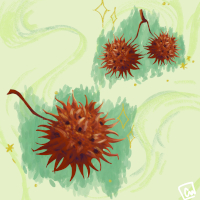by Rebecca Pelky
Mexican Captives Delivered
Santa Fe, New Mexico, 1849
(A found list from a report made to the Bureau of Indian Affairs)
1. Anto Josea, about ten years old, taken
from Jemez, where his parents now live,
by the Navajo who delivered him.
A flock of goats and sheep were stolen
at the same time. He says he was treated well.
2. Theodosia Gonzalez, twelve years of age,
was taken about six years ago, from a corral
near the Rio Grande, where he supposes
his parents now live. He was stolen
while herding goats, but no effort was made
to take the goats. He was well treated.
3. Marceito, eighteen years of age,
was taken from Socorro. He knows
nothing of his parents, nor how long
he has been a captive. The novelty
of a home, as explained to him,
seemed to excite him somewhat.
Osage Sub-Agency, 1850
(A found list from a report made to the Bureau of Indian Affairs)
Agreeably to instructions
from the Commissioner of Indian Affairs
I have, with the aid of the United States
interpreter, ascertained that the number
of births the past year among the Osages
amounts to about 150.
Number of deaths: 73.
Number of births over
number of deaths: 77.
Of those who died, 17 were men,
25 were women, and 31 children.
There are 9 blind
among this tribe,
5 deaf, and 3 dumb.
Of aged persons
entirely helpless, 18 males.
Of aged persons
entirely helpless, 15 females.
Of cripples entirely helpless, 25.
Making in all who have to be taken care of 75.
P.S.—The Osages have about 10,000 head of horses.
Depredations committed by Snake Indians, 1862-1865:
compiled from the newspapers of Oregon
(from a report made to the Bureau of Indian Affairs, 1865)
August 30: Captain Curry, 1st Oregon cavalry, shot an Indian. His men coming to his assistance shot four more.
November 8: Between Gravelly ford and City of Rocks Major McGarry captured twenty-six Indians; held twenty-four as hostages.
March 14: Battle of Colonel Conner’s forces with Indians.Two hundred and twenty-four Indians left on the field.
April 25: Captain Standifer’s party had a fight with Indians on the Masher. Killed twenty of them.
April 25: Captain Flyme’s detachment made attack on Indians at Big Bend. Killed thirty-eight and took forty squaws.
July 25: Bodies of five persons found on South Salmon, supposed to have been massacred by Indians.
April 30: Lieutenant Waymire’s command engaged the Indians, two hundred strong. The Indians were supposed to lose several.
November 12: Mr. Riely got into an affray with an Indian. Subsequently went with a party and killed an Indian and wounded two squaws.
September 15: At Silver River, Lieutenant Bowen, with forty-five men, encountered three Indians. They killed two and captured the third. While prisoner he succeeded in shooting one of the guard, and was immediately killed.
Recapitulation of statistics relating to population, education, 1873-74
(A found list from a report made to the Bureau of Indian Affairs)
Number of Indians in the United States, exclusive of those in Alaska 275,003
Number of Indians who are mixed-bloods
5,703
Number of Indians who can read
4,008
Number of Missionaries among the Indians
111
Amount contributed by religious societies
$36,864,19
Number of Church buildings
128
Number of births
2,152
Number of deaths
1,490
Number of Indians who wear citizen’s dress
43,953
Number of Indians killed during the year by Indians
214
Number of Indians killed during the year by United States soldiers and citizens 177
Number of white persons killed by Indians
85
Number of white persons committing crimes against Indians
149
Number of white persons punished for crimes against Indians
19
Education, 1891
(found list from reports made to the Bureau of Indian Affairs)
The health of the school has been unusually good during the past year, and I am convinced will continue to grow better as we succeed in getting well arranged in our system of sewage and sanitary provisions.
- During the month of May an epidemic of measles broke out. Twenty-seven cases were reported by the school physician. None of the cases proved fatal, but following the disease were two cases of acute pulmonary tuberculosis among the Jicarilla Apaches. One child died at the school and the other was sent home and died soon after reaching the reservation
- November 15 scarlet fever swept upon us and struck down 68 children in ten days. Eight Indian children died in the school and 30 died on the reservation. January 14, when the fever had apparently vanished and we believed the worst to be over, our own little girl 4 years old, the pet of the Indian children and the idol of our home, took sick, and January 19 God called her from earth to heaven.
- Arriving in May full of hope and enthusiasm with 53 new pupils, I took over the situation. My enthusiasm weakened when I found a sick boy had been moved from room to room till there was not the remotest hope of escape. I looked forward to 53 cases of measles and was disappointed only in the fact that this number was exceeded. The weeks of nursing on the part of the employees and suffering on the part of the children proved a black plague to enthusiasm.
- During the past year measles have been epidemic among the Indians here, and owing to the fact that we had no fit place to care for them a large mortality was the result.
- About that time la grippe seized upon us and continued until late in the spring. It was particularly severe upon those affected with scrofula, and also those who either had consumption fully developed or were in the first stages. One child had inflammation of the brain and died. A summary of the records for the year shows the following: Severe cases of scrofula: 11; consumption, 15; sore eyes, 38; mumps, 38; inflammation of brain, 1; chorea, 2; erysipelas, 1. Besides the above there were numerous cases that required and received treatment, but being of minor importance were not recorded. Grant Institute is situated in an extremely healthy locality.
- About the middle of January the mumps broke out. Three pupils were taken simultaneously with the disease, which spread rapidly. I think at least 90 per cent of the pupils were taken with it. This outbreak had a tendency to reduce the number of pupils.
No longer can the Indian say, “Children all die at Chemawa.” They really had no right to say it before, but this shadow of reason therefor is about gone now.



